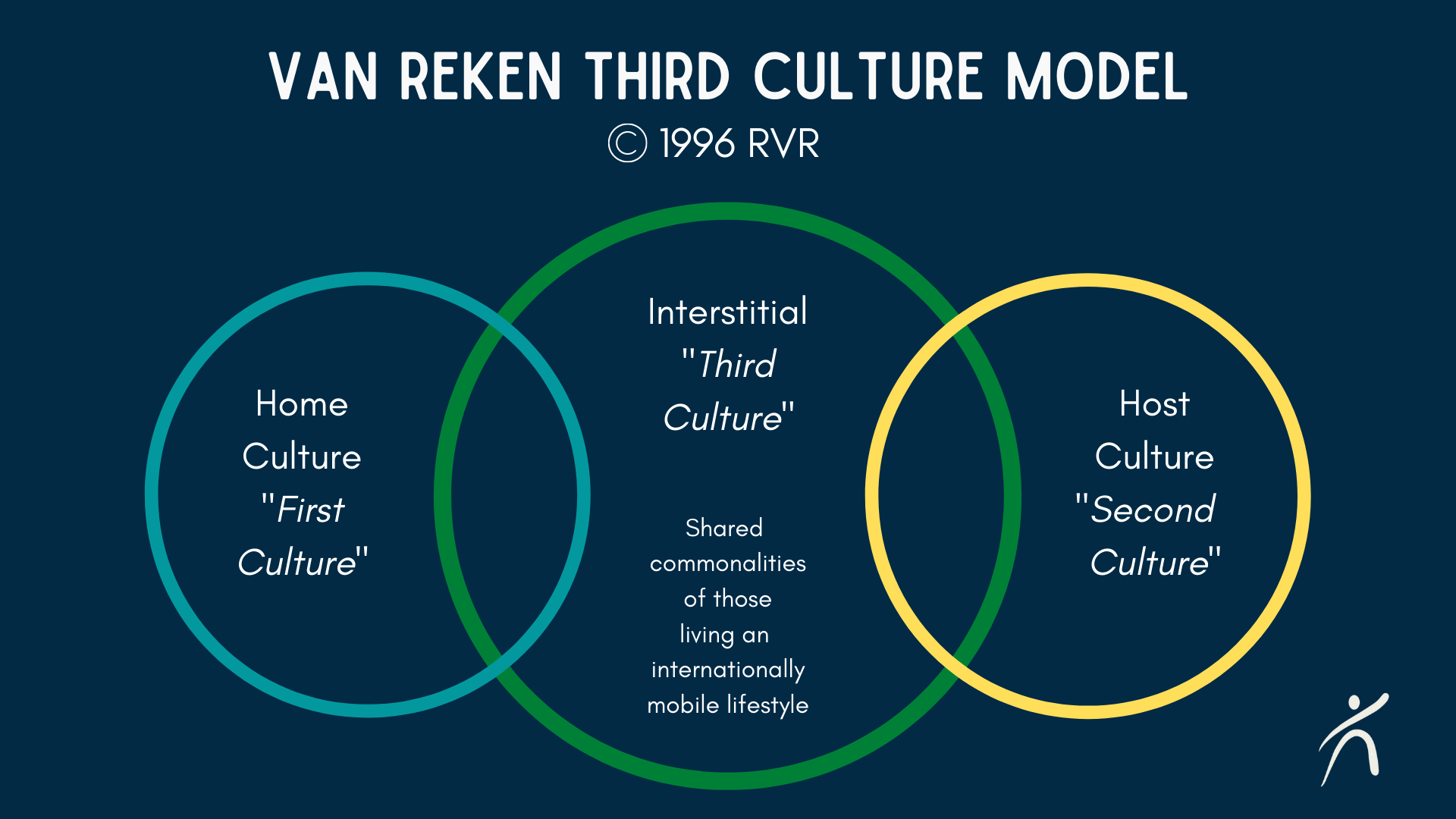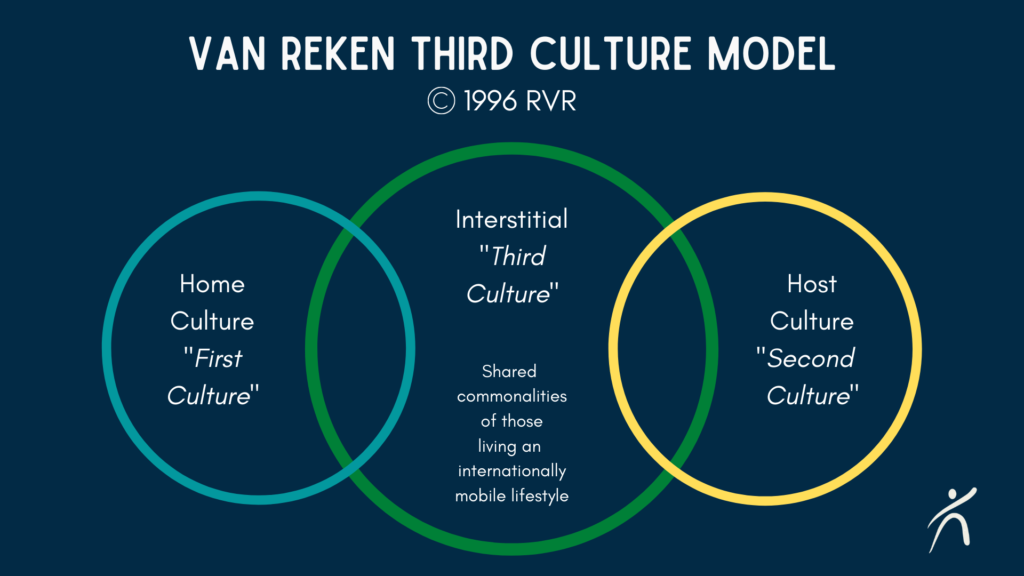2 issues with the RVR Third Culture model
I believe there are 2 issues with the RVR Third Culture model. Before we start to unpack them, I need to say a few things.
I need to begin this post with a clarification–and maybe taking out a life insurance policy. In a day and age when Cancel Culture’s insatiable search for new targets looms around every corner, I wonder if daring to critique Ruth Van Reken’s foundational work is like walking through the forest wearing fake antlers on the opening day of deer season. It’s a perilous endeavor.
I have the utmost respect for Ruth Van Reken’s work and legacy. I consider her a friend and wise sage. She graciously shared some of her stories of the early days Third Culture and TCK development on an episode of TCK Live. We’ve spent time together face to face. We’ve exchanged many emails in the process of writing this article. I shared my perspective on her original three-circle model, and she read this article before I pushed the publish button. I also shared with her my alternate version of the Third Culture Model that I will unpack in a subsequent article.
My intention is to further the conversation. I am not attempting to discredit her groundbreaking work. I appreciate Ruth, her work, and her willingness to humbly engage me and many others.
I love the original TCK Model Ruth first published in the Third Culture Kid book (2nd Edition) but copyrighted in 1996. It’s a good model and I’ve used it for decades. It works. It’s simple, elegant and beautiful. Like Coca Cola, it’s a classic.
In numerous conversations with Ruth, she reminded me that these definitions and models are works in progress. Her model is the first graphic launch pad for furthering the understanding of a complex idea.
Room for Improvement
Dr. Ruth Useem, who coined the term Third Culture Kid, wrote in a letter to David Pollock in 1994, “Concepts change as we get to know more; other times concepts change because of what happens in the world is changing” (Page 21 of the TCK Book). In other words, sometimes even the best work needs to be adapted or modified with additional knowledge or cultural evolutions.
In the previous article I shared 6 flawed models trying to depict Third Culture. They have varying degrees of merit, but, in my opinion, they all failed to accurately convey important or key aspects of the Third Culture.
In this post I share two small bones I have to pick with Ruth’s 1996 pioneering version of the Third Culture model. While still a good model, and one that I would not dissuade others from using, I believe there are two unintended problems with the model that merit reexamination. First, there is an unintended reinforcement of dichotomization that could lend to encouraging cultural segregation. Second, the importance of the Third Culture maintaining autonomy from the host and passport cultures is missing.
First Issue – Forced Cultural Dichotomy
My awareness of a potential issue with Ruth’s model came in the past year as I was reviewing my presentation notes in preparation to teach our Foundations of Organizational MK/TCK Care. When preparing, I typically create a fictional “Jonny TCK” with a ”“Host” and “Passport” culture based on one or more of the participants’ cultural experiences.
I illustrate how each culture is unique from the other, but the Third Culture is distinct from either of those two cultures. Typically the chosen cultures are combinations like Canada and Kenya, Brazil and Afghanistan, England and Indonesia. There are so many different combinations with clear and easy cultural distinctions. However I tripped myself up on this particular occasion; I was about to choose England and Australia for my class illustration.
When choosing what are stereotypically divergent cultures, the three-circle model created by RVR works beautifully. It is clear where to categorize overt cultural differences like language of business, religious beliefs, time orientation, food, etc. The participants can easily catalogue each cultural preference as belonging to either the “host” or “passport” culture we’ve picked for the day’s example..
Using the example of a TCK whose parents join the American foreign service and are assigned to work in Nepal, I might ask the participants which section to place the following words: English, Nepali, Christianity, Hinduism, Time Oriented, Event oriented, coffee, and tea. The participants quickly end up with something like this:
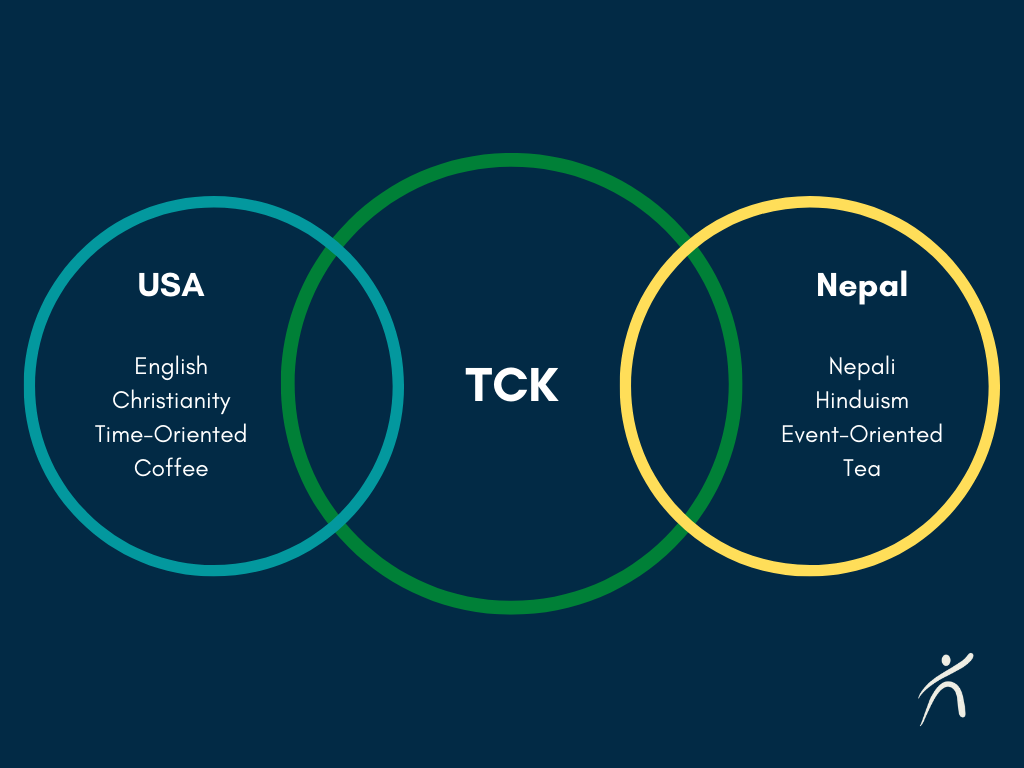
From there I highlight cultural issues typically connected with the TCK profile and help participants visualize how the Third Culture is a culture unique from either of the other two cultures. I would ask them which culture best fits with the following descriptions: high mobility, relationally rooted (not geographically rooted), hidden immigrant, multilingual, ambiguous loss, global connections. We add that to the graphic and the masterpiece is complete.
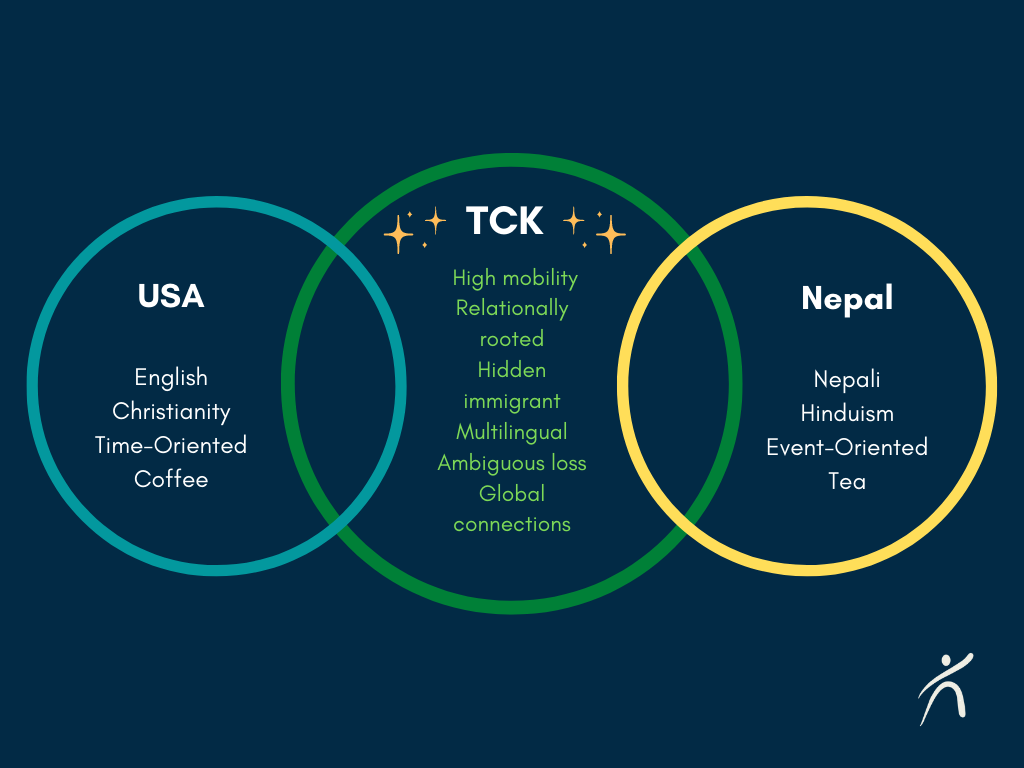
With a poignant pause, I lean back and watch the adult trainees take it in. Light bulb moments flash across their faces, fingers begin to feverishly pound out life changing notes, and somewhere, in the distance, a bell rings and another TCK gets their wings (plastic ones, from an airline pilot).
But as you may already be anticipating, this grand crescendo moment in the presentation began to clang and gong uncomfortably in my mind as I thought through the implications of the two countries being England and Australia. Running through my mind on how to make Australian and British culturally distinct from each other, my typical go-to categories (language, religion, food–yes, there’s Vegemite, but one food does not a category make) didn’t work as easily. The model was about to get messy. The two cultures had too many overlapping similarities. They both speak English. Both are post-Christian. Both have McDonalds. Both are Commonwealth nations. And both are mad about cricket- especially Ashes cricket! What was I going to do?!
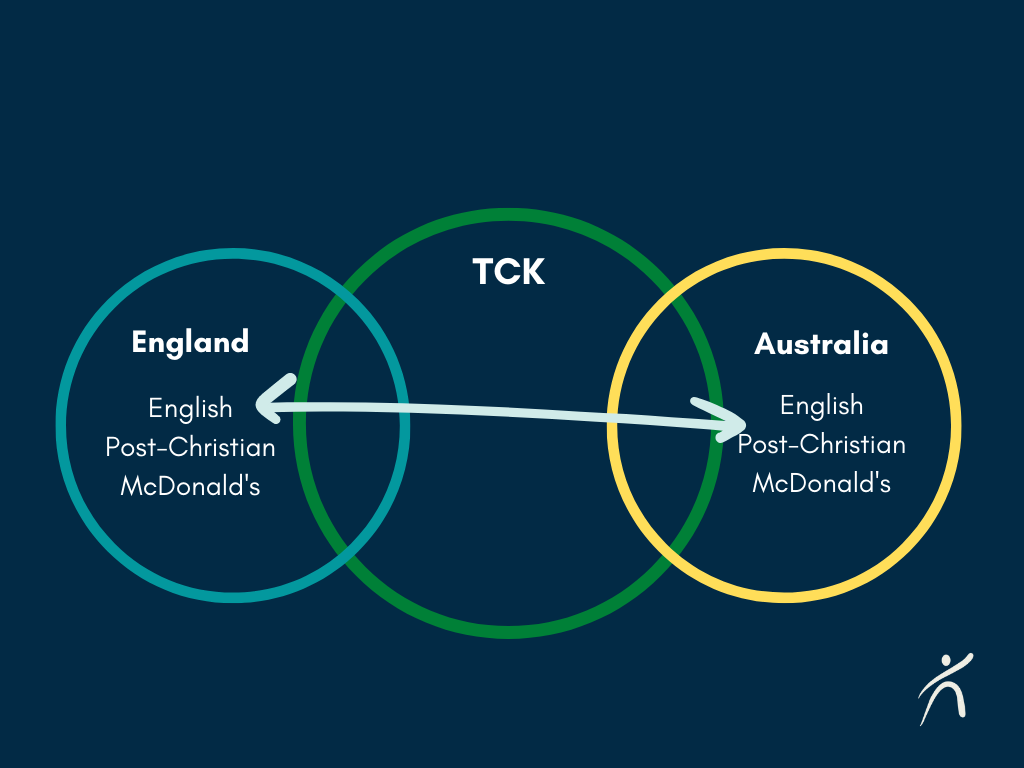
Now before my inbox gets filled up with well-deserved complaints about what an ignorant and ethnocentric American I am not knowing the “obvious” cultural differences between the “Home of Queen Elizabeth” and the “Land Down Under,” I’d like to point out the two countries are nearly identical on 5 out of 6 of Hofstede’s categories .
Side note, Hofstede’s country comparison is a fantastic place to allow TCK teens to play and visually see the cultural stresses that may exist between their external cultures they navigate. I highly recommend incorporating it into your cross-cultural transition seminar material.
Returning to the three-circle diagram, I faced an issue–Venn Diagrams are supposed to overlap where there are commonalities. But in the RVR Third Culture model, the host and passport country do not overlap at all with each other. For the sake of emphasizing the uniqueness of the Third Culture, the RVR Third Culture model separates the primary and secondary cultures as being completely distinct from each other. But in this moment of clarity, the model inadvertently pits the host and passport cultures against each other. So, for TCKs who find fluidity in their geographical home, the model graphically places pieces of their cultural roots at odds with each other. It’s one or the other, never both.
In this day and age with heightened cultural sensitivity and inclusivity valued in much of the Western world, a model that does not allow or permit for similarities and commonalities to exist may be interpreted as (insert correct “woke” word here).
With this revelation of the host and passport culture often having commonalities, especially in the age of globalization, several new thoughts and moments began to spin through my head. Like a cascade of water, the ramifications of needing to better represent the Third Culture and the dynamic life TCKs experience among mainstream cultures in addition to their own interstitial culture flooded my mind.
Model Revised, but new issues arise
My knee-jerk response was to slide the circles around to form an echo of the flawed models I shared previously, just label them differently. A diagram that may look something like this:
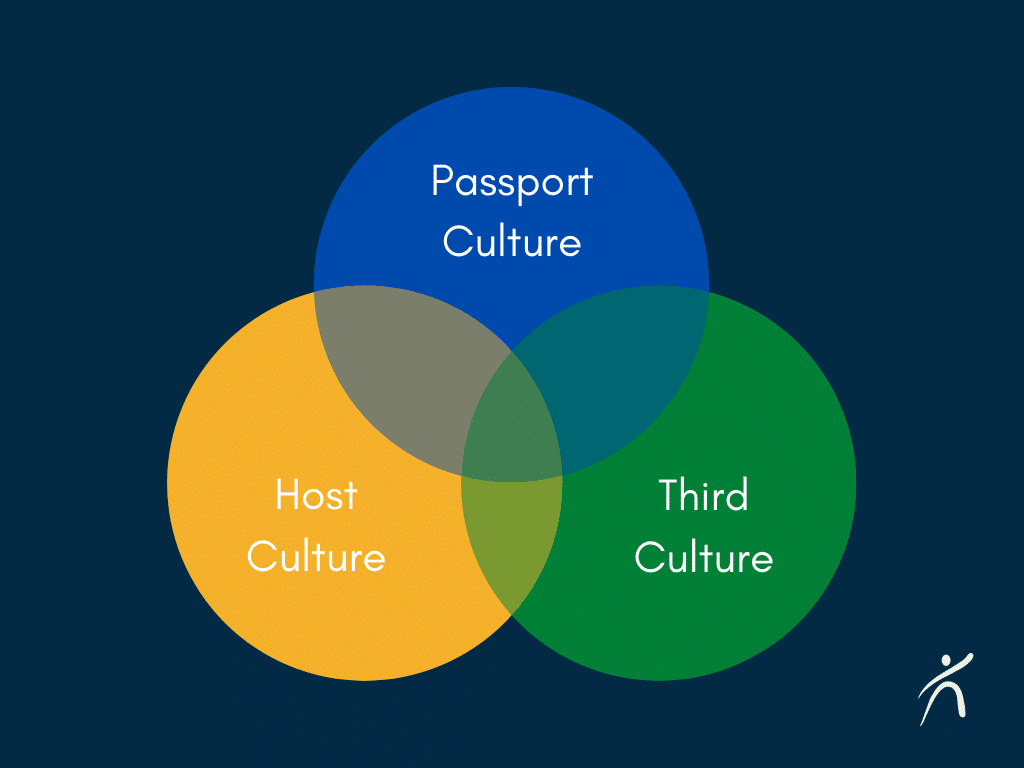
This adapted model differs from the flawed diagrams from my previous article because Third Culture is not labeled as existing at the nexus of all cultures, but rather the entirety of a separate circle like RVRs’ model. The Third Culture is now unique and still interplays with the first and second cultures. The Third Culture is the entirety of the green circle, not just a section or an overlap.
But as I processed my conundrum aloud with my good friend and Interaction International colleague Sheryl O’Bryan, I began to realize that while this resolved allowing there to be places of harmony between host and passport cultures, it didn’t solve the problem.
A Second Complication- Uniqueness of TCK
A second complication began to crystalize in my mind with the historical model. If each ring in this modified model represents a culture, and the Third Culture, as articulated by Dr Ruth Useem, is distinct from other cultures but shared with others who have had high cross-cultural mobility, the Third Culture ring should not overlap any other culture. In essence, it needs to stand apart.
I had to revisit my original understanding of the Third Culture. While it is birthed out of a confluence of two or more cultural exposures, it is wholly distinct. It does not borrow or share with other recognizable cultures. How is that possible?
To highlight the uniqueness of the Third Culture apart from other accepted cultures, ask yourself questions like: what is the language of the Third Culture? What is the faith of the Third Culture? What are the foods, the fashions, the arts of the Third Culture? The Third Culture doesn’t appear to have many (if any) outward expressions of an observable culture. We know this is true because one cannot immediately identify a TCK simply by their appearance and rarely by their outward behavior.
Those who live in the Third Culture seem to develop a radar, a special 6th sense, a gravitational pull of sorts, to find one another. Be it the quick deep breath and pause when they are asked where they are from, a slight biting of the lip when a group talks about political or especially global issues, a slowness to volunteer their opinions or values, awkwardly asking for clarification of an event or slang word that everyone else in the otherwise homogeneous clique knows. All raise the question, “Is this another TCK?” Perhaps this is why so many TCKs connect with the term hidden immigrant.

So, while there may be limited outward expressions of the Third Culture, the deeper cultural values are where TCKs find more uniformity. However, most of that may even exist, ironically, in the lack of uniformity. The Third Culture as a whole leans towards not only a tolerance, but an appreciation of diverse customs, values, and belief systems. In this synchretistic if not pluralistic view of the world, the culture of the Global Nomads seems to find its commonality in embracing the differences. Living between worlds yet never feeling full ownership of a place on this globe contributes to this commonality of diversity. Thus, TCKs are well described as members of the Interstitial Culture.
When identifying the benefits and challenges of the TCK profile as expressed in Third Culture Kids: Growing Up Among Worlds, descriptions including an expanded worldview, a three-dimensional view of the word, and ignorance of (passport) culture are used. Other tendencies ascribed to TCKs include ambiguous loss, identity confusion, and dynamic problem-solving skills. One of the gifts, maybe even hallmarks of being a TCK, is the chameleon-like ability to quickly adapt to their cultural surroundings–or to choose to brashly stand out.
These–and many others–are a mix of perceptions, attitudes, beliefs, and values connected to the Third Culture. They are distinct from basically any other culture of the world. In the beautiful kaleidoscope of cultures around this planet, the Third Culture seems to wander among them all without finding true companionship among the multitudes.
TCK Snobbishness
Because the Third Culture is distinct from all other cultures, it can have the appearance of elitism–a “better than you” snobbery. While I’ve seen some brandish their TCKness as a weapon of mass condescension against monoculturals to whom they relate, those TCKs often find their hubris results in loneliness. When you are in a cultural minority, claiming superiority is a one-way ticket to ridicule, ostracization, and isolation.
To that end, I encourage TCKs to have hope. There are, in fact, many others out there, hidden in plain sight, who are like you. The number of individuals who have had significant experience crossing cultures through their developmental years is astounding. I’ve read claims (none with numbers I can verify) that if the larger umbrella of Cross-Cultural Kids (of which TCKs is a sub group) were a nation, it would be the third largest in the world.
However, don’t limit yourself to finding “homeness” within your TCK tribe. There are many others out there who will embrace you in the beauty and the hang ups of your TCKness. When I remind TCKs that David Pollock, arguably the greatest champion of TCKs in the 20th century, was not a TCK, there is hope for an end to feeling isolated. You will find people with whom you can trust your wandering roots.
Need for Study
Cultures are like the dunes of the Sahara; they constantly change through the influence of their surroundings. While the normative cultures of this world adapt, we need academics and cultural anthropologists (basically people smarter than me) to continue discovering new nuances and developments on the trail blazed by Dr. Useem and so many others.
What are those core, defining cultural values born out of high mobility in cross-cultural contexts? How is the Third Culture homogeneous in its proclivity for inclusiveness and permissiveness of other cultures? What are new trails of understanding that need to be hacked out of the constantly evolving jungle of the Third Culture? Let’s see some scholarship that can answer these questions!
Alas, I have exceeded and trod beyond the scope of what I have “learnt,” so I will return from my ponderings about the solitary nature of the Global Nomad’s culture and refocus on solving the issue at hand. Is there a way to better graphically depict the Third Culture?
Wrapping Up and Looking Ahead
Ruth Van Reken’s model is still worth using. It has stood the test of time. That alone speaks volumes.
However, a potential area for growth is figuring out how to acknowledge and to graphically represent that it forces cultural dichotomies when, in reality, cultures overlap to at least a small degree. It also indicates the Third Culture has attributes of both passport and host culture when maybe the Third Culture is wholly unique.
As Sheryl and I bounced around ideas, a solution percolated to the top that seemed to respect the uniqueness of Third Culture, and, best of all, provide an opportunity for a flexible model allowing individual TCKs to represent distinctiveness in their expression of the Third Culture and their personal culture mix. In this fourth and final piece of this series, I will offer, for your consideration, an alternative model which may connect better with TCKs trying to express themselves while reinforcing the interstitial nature of the Third Culture. Stay tuned.
Update – Part 4: The Adaptable TCK Model has posted
Bret Taylor is the Interim Executive Director of Interaction International. He’s been working with MKs/TCKs since 1999. He’s co-host of TCK Live, directs the Transit Lounge programs, presents at MK/TCK Caregiver Training, chairs MKCS, and helps with Among Worlds, Interaction International’s magazine for and by Adult Third Culture Kids.

